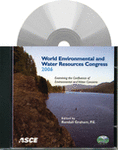Water Balance for a Predominantly Surface Irrigated District in Southern Idaho
Publication: World Environmental and Water Resource Congress 2006: Examining the Confluence of Environmental and Water Concerns
Abstract
Water quantity and quality are being measured in an 82,000 ha irrigation district in southern Idaho to determine the effects of conservation practices, primarily conversion from furrow to sprinkler irrigation, for the Conservation Effects Assessment Project (CEAP). The percentage of sprinkler irrigated land has steadily increased from about 10% in 1990 to more than 30% in 2005. The objective of this study was to calculate a preliminary water and soluble salt balance for April through November, 2005. The water balance was calculated by subtracting measured outflow and estimated crop water use from measured inflow and precipitation. Precipitation was about 250% of normal in April and May, which delayed irrigation for many crops and probably increased the amount of return flow during these months. Water diverted for irrigation was 82% of the total water input to the irrigation district (inflow plus precipitation). Precipitation contributed 16% of the total input. Thirty-six percent of the diverted water left the irrigation district as surface return flow from April through November. This percentage will increase on an annual basis because return flow continues through the winter months after irrigation diversions have ceased. The irrigation district was a source of suspended sediment and a sink for soluble salts. April through November 2005 monitoring showed a net gain of 1620 kg ha–1 of soluble salts in the irrigation district, which could be a long-term concern if these salts accumulate in the root zone. Net sediment loss was 102 kg ha–1, which is less than the 461 kg ha–1 measured during a similar study in 1971. These preliminary results indicate that converting to sprinkler irrigation, along with other conservation practices, has reduced sediment loss from this irrigation district. However, solid conclusions cannot be made until at least one year of monitoring is complete to adequately characterize annual trends, particularly the quantity and quality of non-irrigation season return flows.
Get full access to this chapter
View all available purchase options and get full access to this chapter.
Information & Authors
Information
Published In
Copyright
© 2006 American Society of Civil Engineers.
History
Published online: Apr 26, 2012
ASCE Technical Topics:
- Climates
- Environmental engineering
- Flow (fluid dynamics)
- Fluid dynamics
- Fluid mechanics
- Hydrologic engineering
- Hydrologic properties
- Hydrology
- Infrastructure
- Irrigation
- Irrigation districts
- Irrigation engineering
- Light rail transit
- Meteorology
- Precipitation
- Rail transportation
- Return flow
- Surface irrigation
- Transportation engineering
- Water and water resources
- Water balance
- Water conservation
- Water management
- Water policy
- Water quality
- Water treatment
Authors
Metrics & Citations
Metrics
Citations
Download citation
If you have the appropriate software installed, you can download article citation data to the citation manager of your choice. Simply select your manager software from the list below and click Download.
